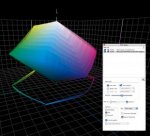Ulrich
Well-known member
Hi
i call this a "challenge": 7-color gamut with Hybrid (Screen SPEKTA I, first generation)
In advance: This is just a theoretical problem, just for "fun", no urgent need for a solution yet, but may be someone is interested in too?
For illustration is here a download with the "original" as an example for difficult blues and screenshots of the bitmapped preview - i hope, that dropbox works:
http://tinyurl.com/hwf6tow

By thinking to satisfy a customer with difficult blues in his RGB-Original for Offset on coated sheetfed, it is a short way to think about higher color gamut to get closer to the RGB original.
But with SPEKTA(I) there is a problem:
The separated Spotcolor channels are bitmapped with dots which lies exactly one above the other and that will cause no stable run, because the risk by a slightly different register is high...
(by the way: may be this is the reason for calling SPEKTA a hybrid, because the dot size is diferently as to see in the screenshots and not only the frequenzy as by trueFM/NP(non periodical)?)
I think: Channel mapping the spotcolors to a complementary color could be an idea, but that would not be very smart to handle (spot Green to magenta, spot Blue to yellow and spot red to cyan).
Any ideas or knowledge how to face this very special challenge are welcome, also recommendations for an other color space and profile for more satisfying the RGB-blue?
(I´m sorry: Me is not allowed to share the profile, but you can ask Christian Piskulla, the editor of http://www.cleverprinting.de/experimente/ to get the profile: Cleverprinting_Exp_7c_09_05_2013.icc)
Is this still a problom in SPEKTA II (second Generation)?
And: Would be this a problem for other FMscreens? I guess not, if really the frequenzy of different spotcolor-channels is different..?
And: Any idea how to get a helpfull softproof-preview in photoshop with a 6 or 7 color-profile?
Ulrich
i call this a "challenge": 7-color gamut with Hybrid (Screen SPEKTA I, first generation)
In advance: This is just a theoretical problem, just for "fun", no urgent need for a solution yet, but may be someone is interested in too?
For illustration is here a download with the "original" as an example for difficult blues and screenshots of the bitmapped preview - i hope, that dropbox works:
http://tinyurl.com/hwf6tow
By thinking to satisfy a customer with difficult blues in his RGB-Original for Offset on coated sheetfed, it is a short way to think about higher color gamut to get closer to the RGB original.
But with SPEKTA(I) there is a problem:
The separated Spotcolor channels are bitmapped with dots which lies exactly one above the other and that will cause no stable run, because the risk by a slightly different register is high...
(by the way: may be this is the reason for calling SPEKTA a hybrid, because the dot size is diferently as to see in the screenshots and not only the frequenzy as by trueFM/NP(non periodical)?)
I think: Channel mapping the spotcolors to a complementary color could be an idea, but that would not be very smart to handle (spot Green to magenta, spot Blue to yellow and spot red to cyan).
Any ideas or knowledge how to face this very special challenge are welcome, also recommendations for an other color space and profile for more satisfying the RGB-blue?
(I´m sorry: Me is not allowed to share the profile, but you can ask Christian Piskulla, the editor of http://www.cleverprinting.de/experimente/ to get the profile: Cleverprinting_Exp_7c_09_05_2013.icc)
Is this still a problom in SPEKTA II (second Generation)?
And: Would be this a problem for other FMscreens? I guess not, if really the frequenzy of different spotcolor-channels is different..?
And: Any idea how to get a helpfull softproof-preview in photoshop with a 6 or 7 color-profile?
Ulrich
Last edited:













